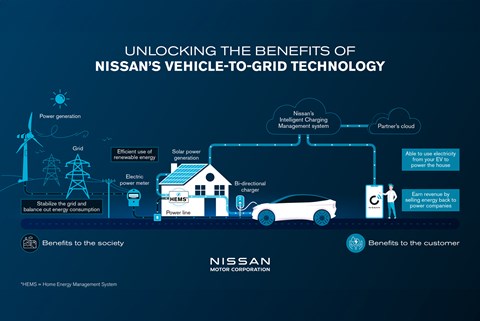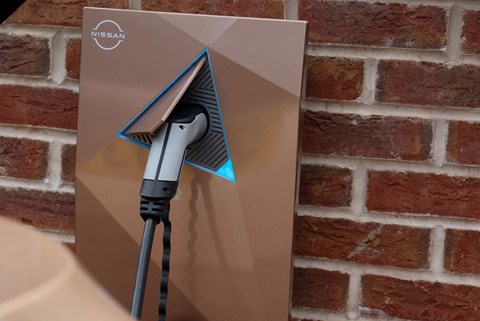► Nissan confirms it will roll out vehicle-to-grid tech
► Will launch in 2026 on ‘selected’ EVs
► Part of Nissan’s expansion and electrification plans
Nissan has confirmed it will launch new cars with vehicle-to-grid technology, with the first arriving in 2026. The brand says it will offer ‘affordable’ vehicle-to-grid technology and is the first in the UK to achieve power grid certification.
‘The days are over that we just look at a car as a vehicle to bring us from A to B,’ says Nissan senior vice president for sustainability and corporate affairs, Friederike Kienitz.
Nissan has been engineering its own V2G technology for the last few years with help from Enovates (a charger developer), Dreev (a subsidiary of EDF Energy) and a trial location at the University of Nottingham. The V2G technology will launch on an updated version of the Ariya, as well as future EVs.
‘On a vehicle today, you have a charger that you plug into your AC current, and then the car manages the conversion of that AC into DC and puts it in the battery, which is then later used to power the wheels,’ says senior vice president for research and development, David Moss. ‘We simply want to reverse that process in a cost-effective way.’

Vehicle-to-grid technology – also known as bi-directional charging – allows an electric car to be charged conventionally at home. But the charger setup also allows power to be fed from the car’s battery back into the national power grid during times of peak demand. The idea is that, during peak times, the grid can request a set amount of charge from your electric car to relieve strain and then return the same amount of charge at another period – likely when electricity demand is low and therefore cheaper. You need a car with the technology on board to discharge itself via its plug socket as well as a wallbox that can manage the flow of power.
Why is Nissan bothering? Well, first of all, this V2G project is part of its ‘Ark’ business plan to see it into the 2030s. As well as helping to decarbonise the brand globally, the Ark plan includes an enormous expansion and overhaul of its global product ranges. ‘We are bringing four EVs to the market [over the next few years],’ adds Kienitz. ‘Three models [for Europe] – Juke, Leaf and Qashqai – are going to be EVs, and produced at the Sunderland plant.’ The fourth is the upcoming Micra – twinned with Renault’s 5 EV.

Like Renault, Nissan plans to offer a (rather stylish) wallbox home charger and a tariff designed to maximise the benefits of bi-directional charging when it launches. Nissan says that, for an average semi-detached homeowner with a rough working time out of the house between 07:45 and 17:45, V2G charging could halve the cost of electricity bills. All very nominal and representative, but Nissan is convinced it’s a serious benefit.
And so does the likes of EDF Energy. While showing us official National Grid projections of future energy usage, the widespread adoption of V2G technology would be a huge positive impact on the grid’s ability to cope. ‘In the UK, there aren’t enough grid connections to electrify everything we need to electrify at the moment,’ says Rebecca Rosling, head of future energy systems at EDF Energy UK. ‘To fix that will be long and expensive, albeit achievable. But doing anything like [widespread V2G adoption] that helps us to use the grid to the best of its ability makes a huge difference.’